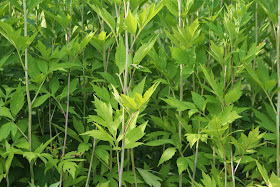Long ago, when the North Woods were still new to me, when the walk down Lenox Avenue to the park felt raw, when Harlem was a foreign country; last year, in fact - you may remember that I walked over a dry and cut down field, through which water ran, and that these fallen stems made me wonder. What on earth would they be, come the new growing year? Now I know. Cup plant, Silphium perfoliatum. Ten feet tall.
I am sorry about the fence. There is a lot of new fencing, but there has also been a lot of horticultural attention paid to these woods over the last few months. There are hundreds of new plantings, and the woodchips are fresh. But the protective fences do get in the way of every single picture and rather ruin the effect, as well as one's appreciation of the landscape.
Across a nearby road in full sun I saw a flower I did not know. Feathery, compound leaves like an Acacia's.
It turns out to be patridge pea, Chamaecrista fasciculata, native to the eastern US, and rather tasty if you are a quail residing in Alabama.
And I am having some trouble with the Helianthus genus. I may be confusing sunchokes (aka Jerusalem artichokes, Helianthus tuberosus) with woodland sunflower (Helianthus divaricatus). Here is one, below. The woodland sunflower is apparently almost stalkless (known as sessile, without a petiole), when it comes to leaf attachment. I see a petiole, below.
This is a different clump - see more petals, and slight dentation (toothing) on the leaves? So...?
Too confuse matters farther, here is another yellow daisy. Rudbeckia laciniata, in the background, behind the ironweed. [Correction: that be Joe Pye-weed, as pointed out in the comments.]
At least it has shredded leaves, to help distinguish it. And for that confusing cold season, these stems were probably mixed with those of the cup plant. They are also very, very tall.
And finally, the black-eyed Susan we all know: Rudbeckia fulgida.
I was lucky enough to catch the tail end of the wild lilies. I think they are Lilium lancifolium, or tiger lily.
Whoever thought tigers had spots?
To join me on a plant here (with only occasional head scratching), please visit the link:
* Summer Botanical Walk Schedule *
To join me on a plant here (with only occasional head scratching), please visit the link:
* Summer Botanical Walk Schedule *











Lovely pics - just curious, though about the tall lavender colored flowers - I think that they're Joe-Pye weeds, not ironweed.
ReplyDeleteYou are right. I totally fluffed up. Thank you.
Delete